As gardeners we’re always told to mulch our gardens, but why? Why should we invest so much time and money on mulch? What is the best type of mulch to use, and are all mulches created equal?
Read on as we answer these questions, plus a bunch more as we cover the basics of garden mulching.
More...
What is Mulch?
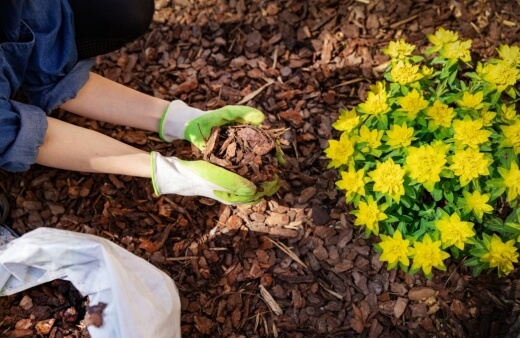
This is actually less clear-cut than you might think. Generally, mulch refers to any non-living thing that covers bare soil (when I say non-living, I mean in its current state, so not a ground covering plant).
So technically, mulch can include anything that is thrown onto bare soil to cover it.
Commonly speaking though, mulch relates to organic coverings like wood chips, leaf litter, grass clippings and straw, but can also include inorganic covers like rocks and pebbles, plastic matting, or sand.
Personally, when I talk about mulch at work, and to clients, I’m only referring to the organic side of things, and I think this is a pretty common view point for most horticulturalist.
Hard landscapers on the other hand are the ones who I find to be more inclined to include those inorganic types.
Organic mulches
Organic mulch refers to coverings that were once alive and will break down over time. This is by far the most popular type of mulch, and is more than not the left over by-product of a separate gardening task.
Woodchips, grass clippings and leaf litter are the most popular recycled mulch products, but products like straw, sugarcane and hemp mulch also fall into this category.
Each type of organic mulch will break down at different rates, and return the bulk of their nutrients back to the ecosystem in and around your plants and soils.
Inorganic mulches
These are products that are designed for long term coverage of an area, and will not break down over time. Sand beds, gravel, pebbles and plastic weed matting are popular examples.
These are generally more concerned with completely suppressing any plant growth and aesthetics over anything else. You can add some glow stones in the mix for more added colour.
The grey area
Whilst technically organic, chemically treated hardwood chips are available as mulch and these are extremely long lasting and designed not to break down over time like traditional organic mulch.
A lot of the time they also contain artificial dye for colouring which also aids in limiting sun damage, further extending their lifespan. Whilst not truly inorganic, they fit better in that category, based upon their benefits and problems.
Reasons to Use Mulch
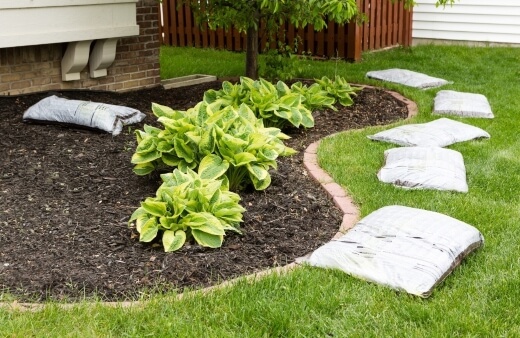
There’s a load of different reasons why we throw mulch onto a garden, and different types of mulch have different benefits associated with it.
By no means is mulching a one size fits all approach, so before deciding upon your mulch type, you need to decide what you’re trying to achieve.
1. Weed suppression
Probably the number 1 reason we mulch is to keep down unwanted plants. Seeds are pretty tough little things, and they’ve evolved to fight their way up through soil to the surface, which is no easy task.
BUT their energy supplies are limited, so if we add an extra hurdle for them to get past, then they’re more likely to run out of energy, and die off before reaching the surface.
A good thick layer of mulch is the perfect extra hurdle. By smothering the soil with a thick layer, we can suppress any weed seeds that want to grow up through, and therefore limit weeds.
Both organic and inorganic mulches will help suppress weeds, but for complete suppression, the winner is inorganic, because they don’t break down over time.
As organic mulches, like grass clippings that form a thick matted layer, break down they essentially create new soil, and are the perfect spot for weed seeds to settle and germinate.
This is why we need to continuously top up organic mulched areas, to cover up each generation of weed seeds that make their way into your garden.
2. Moisture conservation
The second most common reason we mulch is to conserve moisture levels in our soil. Bare soil in summer will dry out up to 70% quicker than covered soil, and that’s not good news for plants in your garden.
A hot day on an un-mulched garden can wreak havoc on your plants, even if you’ve watered them with a lawn sprinkler or retractable garden hose reel. By covering up the soil with mulch, the sun and heat has an extra layer to penetrate before getting to the moist soil around your plant roots, which can literally save your garden in summer.
It’s really important to note here though that you can put too much mulch on your garden, and actually stop water getting into your soil.
Thick clumping mulches like grass clippings and straw mulches can form a barrier and restrict water movement downwards, whereas porous mulches like wood chip and gravel will let more get through.
3. Aesthetic Look
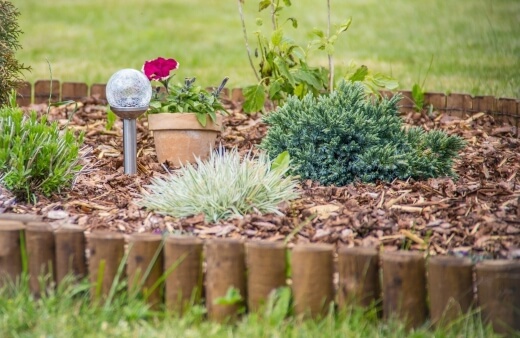
Mulch simply looks better than bare soil. It’s a pretty easy concept, and really changes up a landscape. Different mulches can provide colours and textures for contrast or compliments, and can even be a garden feature itself, such as a raked sand or pebble garden.
This may or may not be the biggest reason for your desire to mulch. It all depends on what you’re trying to achieve. You may be trying to create a particular feel to a landscape and these materials help convey that.
It may be that you just want to neaten up your garden and are laying a backdrop for this. Mulch can provide sensory aspects to your garden, like crunching of gravel, or the smell of fresh eucalyptus wood chips.
4. Soil improvement
As organic mulches break down, they return their nutrients to all the microorganisms in and around the soils and your plants. Organic mulches also provide habitat and food for all the little critters in your garden, and can boost the ecology of your backyard.
This is great if you’re growing a crop for food or for flowers, as good soil is the foundation of good farming. Use a quick decomposing mulch like straw, sugar cane or hemp mulch.
This allows you to till your garden each season and provides essential organic matter each time you plant a new crop.
Other organic mulches also aid your soil by acting as a cushion for your soil, protecting against compaction via feet or vehicles, and can keep your soil warm during winter, preventing frosts and freezing.
Inorganic mulches can actually harm your soil more than improve it, by causing compaction and restricting oxygen flows.
This isn’t a problem for all plants, but for a high turnover, high yield garden, inorganic mulches are simply no good for soil improvements.
Benefits of Mulch
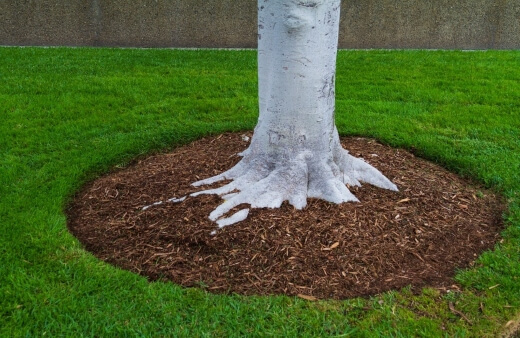
A key component that many people forget about with gardening is mulching, especially in Australia! Mulch provides 2 main benefits;
- Provides organic matter that breaks down to improve the soil
- Provides soil cover, increasing the soil's ability to hold water and limits the ability for weeds to grow.
Mulch comes in very many forms. Most are organic though there is a growing trend to use inorganic materials such as shredded plastics. Like most elements to gardening there will be different tips given for mulching.
The deeper the mulch the better but a good depth to aim for is about 10cm. This will really inhibit the ability for weeds to grow and will trap in a lot of extra moisture.
Common Types of Mulch in Australia
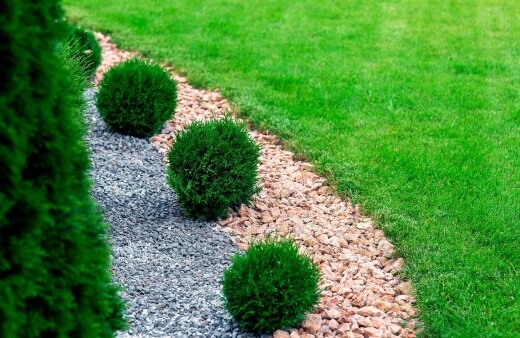
If you’ve followed everything you’ve read so far, you’ll know that the right mulch is going to depend on the situation. Sometimes your preferred choice might not tick all the boxes that you need, and sometimes you might need to make some sacrifices.
More so, there are a range of organic and inorganic types of mulch to choose from.
Below is a summary of the most common types of mulch available, and the pro’s and con’s of each.
Sugar Cane Mulch/Hemp/Straw
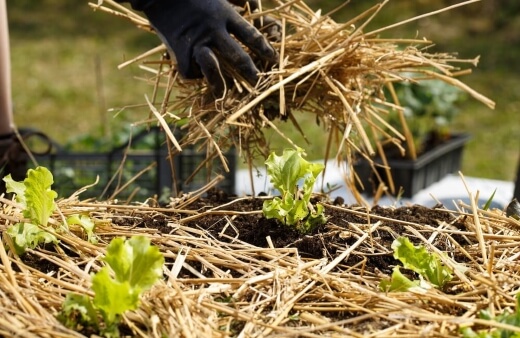
These are great to put around fruit trees and look great in cottage gardens. They’re inexpensive materials and will keep down weeds very effectively. The best way to apply this type of mulch is to first put down some blood and bone fertiliser around the base of the tree.
Overlay this with some newspaper to cover the spread of the tree and then cover the paper with horse or sheep manure (slow-release fertiliser). Finally apply the straw densely over the manure and water in.
A light weight organic product cut up from the plant it has come from. It can quite often be organically produced, and can come in small to large bales. Hemp or straw are a great option especially for vegetable gardens.
Benefits
- Quick break down which adds nutrients to the soil and food for microorganisms.
- Easily worked back into the soil when replaced.
- Suppresses weeds and retains moisture.
- Inexpensive and widely available.
Negatives
- Quick breakdown means regular replacing.
- Easily blow away in high winds.
- Can make an area look a little bit like a farm.
Grass clippings as Mulch
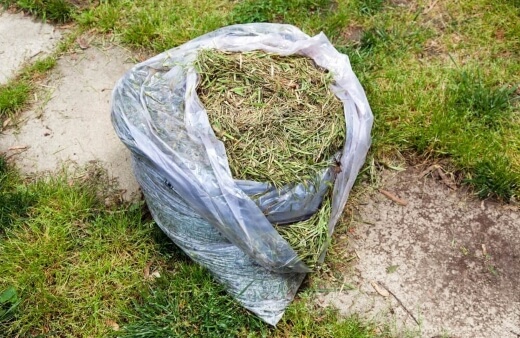
Your leftovers after you mow your lawn. High water content and super quick breaking down.
Benefits
- About as cheap a mulch you can get.
- High organic matter and really quick breakdown.
- Help to cool the root zone, while conserving moisture.
Negatives
- Can clump up over the top of your soil and stop moisture penetration.
- Gets pretty smelly as it decomposes.
- Can contain weed and grass seeds that will germinate in the garden.
- Has next to no visual appeal.
- Because it’s so abundant, people over apply it and it’s easy to get too much mixed through the soil.
Refer to our comprehensive guide all about using grass clippings as mulch for more info.
Woodchips
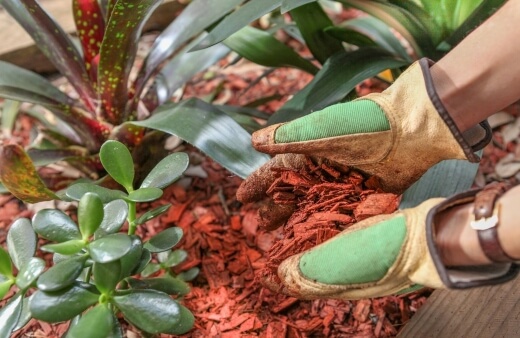
Chipped remains of trees, branches and leaves. Come in a variety of sizes and qualities, ranging from roughly chipped arborist leftovers, through to horticultural grade nursery products.
Benefits
- As they break down they will add organic matter to your soil, and provide habitat and food for microorganisms.
- Easy and cheap to find and install.
- Suppress weeds and retain moisture.
- Products like ‘Forest Fines’ and ‘Hortgrade’ have amazing visual appeal.
Negatives
- Larger chips can be hard to incorporate into soil during tilling.
- Need topping up every season to continue to work.
- Easily washed away in heavy rains.
- Can transport weed seeds and viable cuttings for vegetative growth into your garden.
Leaf Litter as Mulch
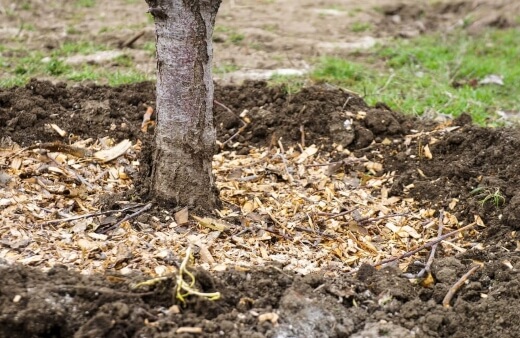
Fallen leaves from trees. Can be from normal year round leaf drop, but mostly from deciduous trees in Autumn.
Benefits
- A great way to use up all those fallen leaves in Autumn.
- Using native leaves little around native plants is a great way to mimic natural processes.
- Breaks down quickly and is great for microorganisms.
Negatives
- Clump together when wet and can get slippery and then dry solid.
- Not very long lasting, and isn’t really available outside of Autumn.
- Very little visual appeal.
Sand Mulch

Can include a variety of different sized granules, colours and the way you present it.
Benefits
- Will cover an area for a long time.
- Allows water to penetrate through to the soil easily.
- Can look amazing in the right context.
Negatives
- Can mix with dirt and begin to look really shabby.
- Really hard to remove if you change your mind.
- Limits any planting changes you may want down the track.
- Plenty of area for weeds to grow in.
Gravel as Mulch
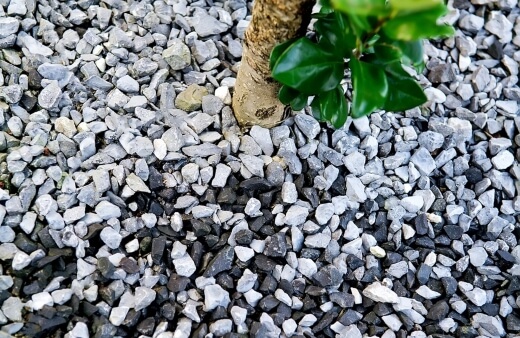
Covers a huge range of different colours, and granule size. Can include loose stones thrown into an area, or decomposed granite or rhyolite that contain a binding agent.
Benefits
- Can look really good in a big open area.
- Almost guarantees no weed growth.
- A long term option.
- Great for pathways, between beds or xeriscaped gardens.
Negatives
- Once it is in, it’s there for good.
- Not much hope for surrounding shrubs or food crops.
- Not a great option for in and around gardens.
- Can heat soil significantly during the summer.
Treated Wood Chips
Treated pine or hardwood timber chips that provide the same visuals as mulch, but take much longer to break down. Often also treated with a coloured dye.
Benefits
- Offers a range of colours to compliment or contrast within the landscape.
- Extremely long lasting, meaning top ups are less often.
- Easily available from nearly every nursery supply store, and often in small easy to transport quantities.
Negatives
- Full of chemicals that will leach into your soil.
- Dyes aren’t as long lasting as wood chips, so they become faded and dull before they break down.
- Because they don’t break down easily, they are tough to get out of an area if you change your mind.
- Ground dwelling bees or bumble bees won’t burrow through the wood chips, so you will need to leave certain spots open for them.
Old Newspaper as Mulch
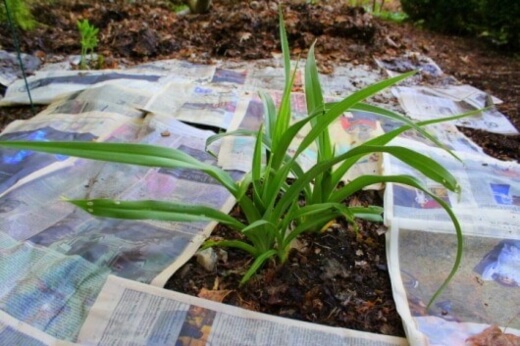
If you’re a fan of recycling, consider repurposing your newspaper into some mulch. Simply put a few pages beneath a layer of straw or pebbles. This will help to discourage weeds.
Benefits
- Keeps soil cool in the heat of summer.
- Helps to save water and encourages earthworms.
Negatives
- Coloured ad inserts are problematic when seeping into soil.
- Can up the nitrogen content of the soil as it decomposes.
Compost as Mulch
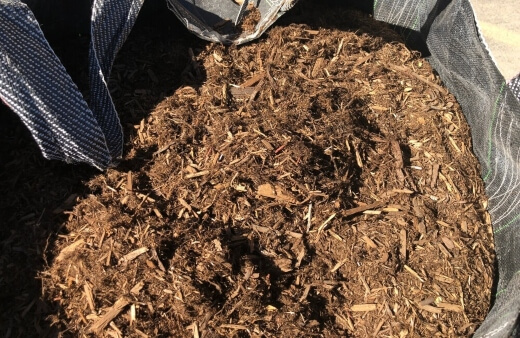
If you’re already composting at home with a compost bin or worm farm, you can always add some compost to your mulch mixture.
Benefits
- Insulates, nourishes and supports evaporation.
- It’s pollinator friendly.
- It’s a very sustainable option.
Negatives
- It decomposes easily, so will need to be replenished often.
- May not suppress weeds as well as other mulches.
Geotextiles
Black sheeting or geotextile landscape sheeting can be lined directly onto the soil. While it won’t have the soil enriching qualities of other mulches, and can significantly repress weeds.
Benefits
- Saves on effort and water.
- A good option for the winter.
Negatives
- It’s not incredibly permeable, so can cause pooling or poor drainage.
- Cheaper options tend to split and break which affects soil quality.
Tea Tree Mulch
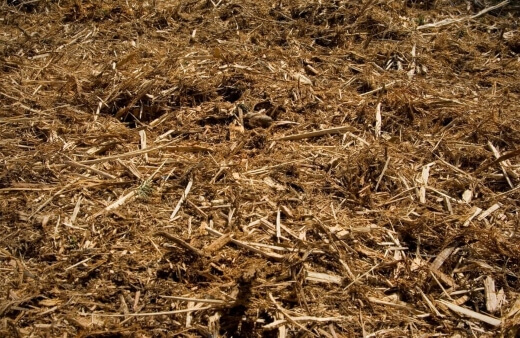
Tea tree mulch is another great option for growers, as it offers a wide range of benefits and longevity. Tea tree mulch is derived from Melaleuca plants, once the oils have been extracted. Making it another very sustainable option.
Benefits
- Tea Tree has a repellent effect on insects and termites.
- High in nutrients like nitrogen, potash and phosphorous.
- Has a natural look, feel and colour.
Negatives
- Sometimes oil residues remain and can cause it to clump together.
- It can be quite dusty when working with.
Getting to Know the Mulch Industry
Many home gardeners opt to buy mulch when the weather begins to warm. In an effort to protect their garden beds from water evaporation and help combat weed growth they instinctively purchase large mulch loads and then spend the weekend dispersing it.
But, have you ever considered what goes into making that load of mulch?
Presumably it’s bark and leaf matter that’s been recycled as a byproduct of the timber millers. And, in many cases this is what you’re getting. However, if you expect it to be 100% of the overall product you’re either living in denial or ignorance is bliss.
Many mulch wholesalers and manufacturers will substitute a variety of items to bulk up their volumes. Wood pallets and crates – usually made from foreign timbers are a great alternative to sourcing natural timber fibres.
And, while we would like to believe that it is just the waste products that are being used, many times the whole tree including the inner core is ground.
While this is still all natural it means that you’re the one getting the raw end of the stick. The inner trunk of the tree will decompose far quicker than the bark which means you will have to mulch your garden more often.
Suppliers who mulch the whole tree and import softwoods benefit from cheaper overhead costs and also from increased customer orders but usually charge similar prices to quality providers.
Things to Consider When Buying Mulch
Before you allow the mulch to be offloaded onto your driveway, check the contents. Here are some things you should be able to look for and discuss with the supplier;
- Check for green or light-coloured wood – bark mulch should be fairly dry to moist if it is old enough and should have a dusty feel about it. Softwood that has been sitting in a mulch pile for some time will look greenish and have a slimy texture.
- Ask the supplier where they source their mulch from – many tree removal companies run a mulching arm as part of the business operations. While this is not a bad thing and the mulch produced will have no ill-effects on your gardens, it is an inferior product compared to milled bark and should be much cheaper.
- Ask how long it is stored for – the longer the mulch is stored the more decomposing has already taken place. If the mulch has been sitting in their yard for some time then it may rot down too quickly in your garden beds, and thereby force you to buy more later in the season.
The best mulch you can get is from recycling your own plants and materials, and it’s cheaper too. But if you must buy from a mulch supplier, take the time to find out what you’re getting and don’t just settle for what you’ve been given.
When to Use Mulch
In spring we will commence the annual mulching of our garden beds before the summer season arrives. This will aid in halting evaporation that removes the water from our plants that we pay so much for.
I’m a big fan of mulch, not only for its purposes but also for its aesthetic qualities. It’s like putting a black background behind a photograph.
If you want to neaten your garden before you put it on the real estate market – mulch the beds. It makes an incredible difference. I’ve seen homeowners who have done this and instantly the house looks better.
Calculating How Much Mulch is Needed
To calculate the mulch in quality, especially in square meter, we are solving the given example:
Consider we are covering around 20 m by 10 m of area and depth of the mulch is 5 cm and we are using the cedar as the mulch.
Given:
- The area of the mulch = 200 square meter
- The depth of the mulch = 5 cm = 0.05 m
- The mulch quantity required = ?
Solution:
- The mulch quantity required = (Area)(Depth)
- The mulch quantity required = (200 square meter)(0.05 m)
- The mulch quantity required = 10 cubic meter
There are other types of the organic and inorganic mulches available in the market. You need to know exactly what your garden needs and choose the specific type of the mulch. Once you've chosen what mulch to use, you can use mulch calculator to assist you how much to get.
How to Use Mulch
When placing mulch around plants though, it is important not to place it right up to the stem of the plant. Leave a 15-30cm barrier around each of the plants because as mulch breaks down it creates a lot of heat.
If the mulch goes right up to the plant stem, the heat created can actually cause the plant trauma, especially by burning the plants roots. Here is our guide on making tree mulch rings.
The other upside to leaving this space empty is it creates a natural mound ensuring that when the plant is watered, the water will first sink into the soil around the plant and therefore not drain away from the plant.
Now or towards the end of winter give your garden a really good mulching, your plants will need as much moisture as they can get in early spring as they start to wake up from their winter slumber and look to blossom.
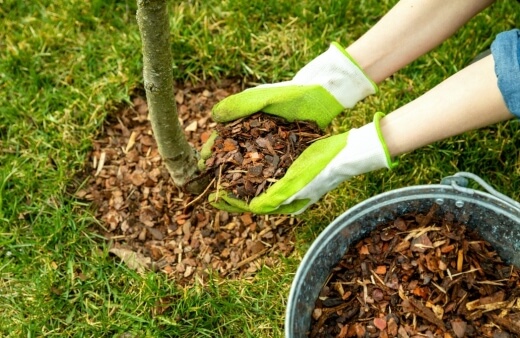
Make sure your garden keeps a healthy layer of mulch throughout summer to best utilise the minimal water available.
A garden that is regularly mulched will stay healthier longer and the plants will be thankful for the regular breakdown of organic matter.
An example of a mulch to try and stay away from is pine chips created from used treated pine. Many places sell this kind of mulch cheap because it has very little benefit in any other form.
The problem is what the pine is treated with is toxic and can cause damage to plants. As the pine breaks down the toxins seep into your garden and into your plants, which can cause great distress to even the most well established shrubs and trees.
Many people ask the question ‘how much money should I spend on mulch?’ In general I think the saying ‘you get what you pay for’ does generally apply.
Any mulch, as long as it isn’t toxic, is better than no mulch but high grade quality mulch generally costs more because it is infused with better organic matter filled with more essential nutrients.
A good mulch can sometimes be as effective as fertiliser. Having said that, a ‘budget mix’ from places like soils aint soils is very effective and is what I generally use in gardens.
I try to stay away from the super cheap mulches from shops like Bunnings but they are still better than having no mulch on your garden whatsoever.
A handy website for gardeners in WA is mulchnet. MulchNet provides links to sources for mulch, including FREE mulch, both delivered and available for pick up. Check it out, it is fantastic!
Is it possible to over-mulch your garden?
Like anything, moderation is good. Mulch volcanoes around the base of trees can actually prohibit the tree’s success. The same can be said if too much mulch is applied to a garden bed.
When landscaping your garden the most mulch you would want to apply is 10-15 cm (4-5 in) of organic material and approximately 5 cm (2 in) of inorganic material.
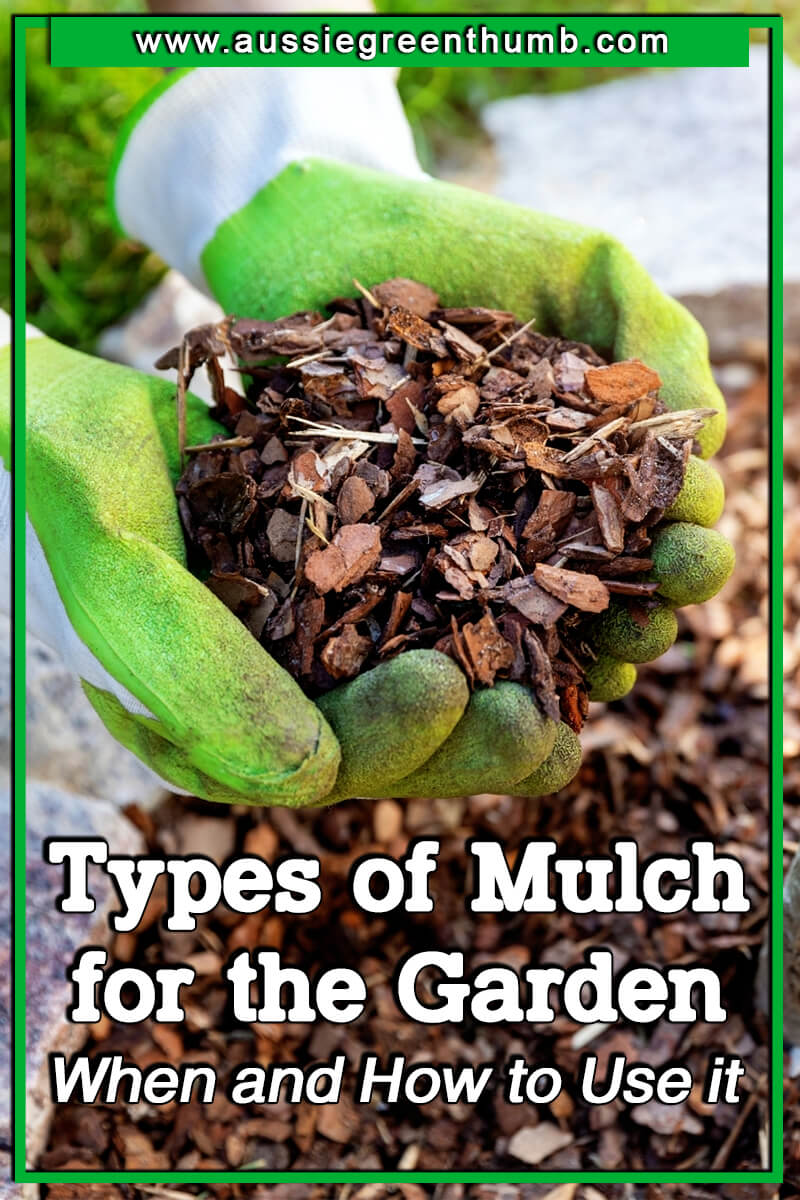
Get Ready to Get Mulching!
Mulching is such an important part of garden care. It’ll protect your plants, repel weeds and support your soil for happy growing plants year-round. When choosing which kind of mulch to use, it is always a good idea to look into the best mulch for the specific plant it’s for.
As each type of mulch carries with it it’s own benefits and drawbacks, you’ll want to make sure you’re choosing the right one for your needs. Start mulching today!
Published on October 12, 2021 by Clinton Anderson
Last Updated on December 27, 2023

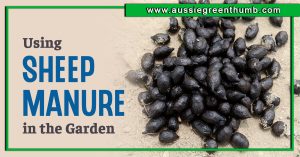

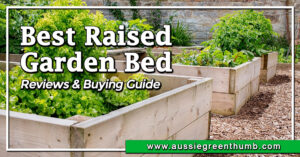

Great article.
Q. Would you recommend putting sugar cane mulch on a plant garden to help suppress weeds and then a red gum mulch to keep it down and stop it blowing?
Hi,
Thank you for your question! We think this is a great idea and should work well. Sugarcane mulch is a great option because it breaks down quickly, is very easy to spread, and is usually more affordable. You may find that you have to add new layers more frequently because of this, however.
The red gum mulch is a good combination to use with the sugarcane because it will give some weight against the wind, protects against erosion, and it breaks down more slowly. We would recommend that you get chips between 20-40mm and apply a fairly thick layer of 50-100mm thick to create a strong protective barrier.
Together, this should provide good weed suppression for all but the most determined weeds!
I hope that answers your question.
The AGT Team
HI, all my pruning i put through a mulching machine its a rough mulch but works .
my question is how do i stop the wife saying its ugly and when im not around raking it up and putting in the bin just leaving sand . the only mulch she wants is black and when it fade tells me i got the wrong stuff rakes it up and bins it. costing me a fortune .
any help ,devorce maybe .
Hi Robert,
Thank you for your question. Obviously, your wife feels very strongly about your mulch, but all great marriages involve compromise!
We’d recommend trying to win your wife over with how beneficial mulch is to the garden – how it retains moisture, suppresses weed growth, and helps make the garden healthier all round.
A second strategy would be to invest in black mulch dye or paint concentrate. This is done by mixing in a black vegetable-based dye into your mulch mix, or even spraying your mulch with the organic dye solution to keep it nice and dark.
Most of these dyes last around 7 months, so they’re much more cost-effective than replacing your mulch every few weeks! You can try any of these recommended products:
•Sanco Industries MulchWorx Black Mulch Colour
•PetraTools Black Mulch Dye
•Mulch Dye Concentrate Colour Renewal
We hope that answers your question, saves your marriage, and shows your garden the love it deserves.
Gary Clarke